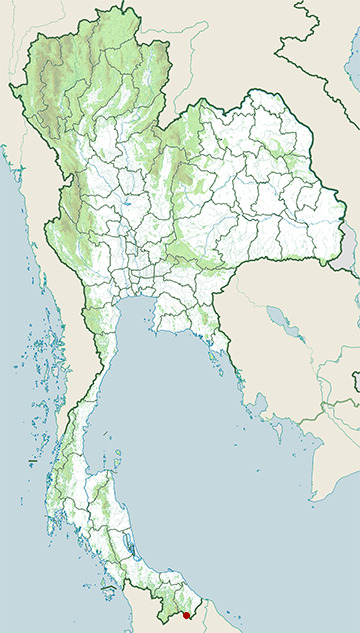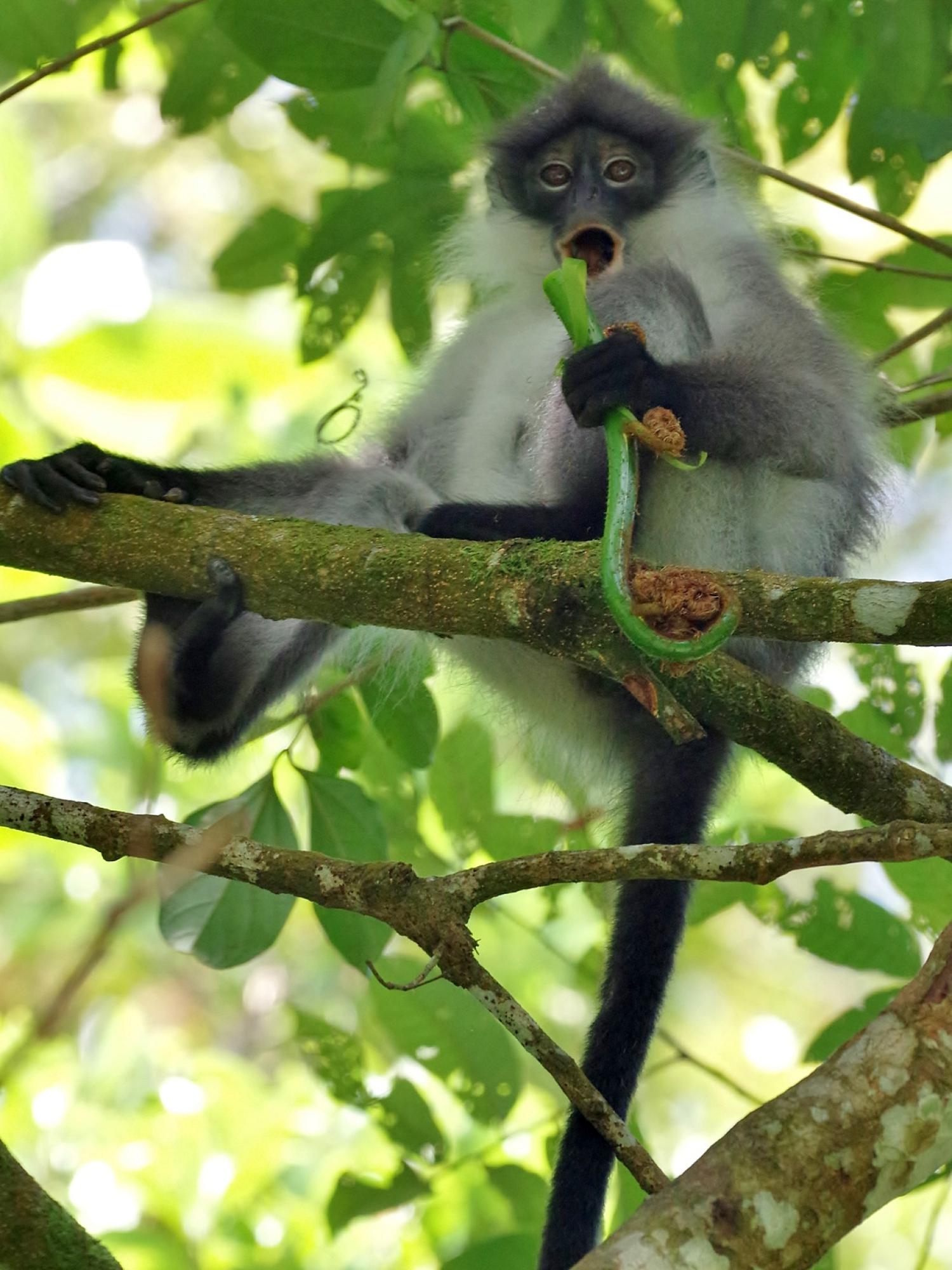Species of Thailand
White-thighed surili
Presbytis siamensis
(Hermann Schlegel & Salomon Müller, 1838)
In Thai: ค่างต้นขานวล
The white-thighed surili (Presbytis siamensis) is a species of primate from the family of old world monkeys (Cercopithecidae). This species lives arboreal amongst the sub-montane forests. It is endemic to the Thai-Malay Peninsula, the Riau Archipelago and Sumatra. In addition, the white-thighed surili contain four subspecies: siamensis (nominate), cana, paenulata and rhionis, are recognized here. Furthermore, they are characterized by the white patches located on the outside of their legs, which is what gives them their name. Additionally, they can be referred to as pale-thighed langur/surili. These primates are an important species for the diversity of forest environments in the Malaysian area.
Physical
The white-thighed surili are made up of a common surili build, ranging from around 41–69 cm tall and weighing 5–6.7 kg. Their slender build is covered with a brown-grey fur coat on their backs, with white fur covering their bellies and dark fur on their head. They are known for the white fur on the outsides of their thighs (giving them their name). Additionally, their tails – typically covered in dark fur – can extend roughly 58–85 cm. Compared to adults, infants are born with very light fur with crosses of dark fur along their arms and back.
Habitat
As an arboreal species, P. siamensis live in subtropical/tropical forest environments. They have been found to occupy moist lowland or swamp areas. In fact, they can even be inhabitants of terrestrial environments; for example, rural gardens. They can be located mainly on the Malay Peninsula, but are also found in Sumatra, as well as some parts of Thailand.
Social organization
The white-thighed surili live in small unimale-multifemale groups. After mating, females give birth to single infants to which the group of females care for. Due to their arboreal lifestyle, reliance on detection of predators is vital. Male group members are able to call or display a distraction for predators to protect group members. Furthermore, this predator avoidance strategy is shown to be more effective with smaller groups.
Taxonomy
P. siamensis is a member of old world monkeys. P. siamensis itself contains four subspecies: siamensis, cana, paenulata, and rhionis. Research suggests the white-thighed surili includes P. natunae (Natuna Island surili) as a subspecies; however both have been considered subspecies of P. femoralis (Banded surili). Alternatively, research suggests three species are endemic to Malaysia: P. siamensis, P. femoralis and P. robinsoni (Robinson's Banded langur). Through mitochondria DNA analysis, these three species are split into two separate clades: P. femoralis on its own, P. robinsoni and P. siamensis in the other. This was due to the sharing of unique nucleotides between P. robinsoni and P. siamensis. There continues to be ongoing evolution of Robinson's banded langur and the white-thighed surili.
Research suggests that P. femoralis was the basal lineage of Presbytis in peninsular Malaysia. It was hypothesized that P. femoralis diverged to form P. robinsoni and P. siamensis. The movement of P. femoralis to the Malaysian peninsula created the allopatric distribution. Further dispersal on the peninsula itself resulted in the divergence of P. robinsoni and P. siamensis through allopatric speciation. Overall, the taxonomy is constantly evolving and in need of continuing research.
Threats
According to the IUCN Red List, the current status of the white-thighed surili is near threatened. Researchers say several Presbytis species are affected by logging activities, although not all of them are recognized on the IUCN red list.
Conservation efforts for non-human primates - such as the white-thighed surili - are valued significantly. This species is seen in the public's eye as a value of science, genetics, forest sustainability, aesthetic, tourism, and a symbol of heritage. Researchers suggest continuing to familiarize the public with primate conservation concerns to enhance the willingness of participate in conservation efforts. In addition, only 30% of the forested area on the Malaysian Peninsula is legally protected from resource extraction, leaving 70% of forests vulnerable. More research on abundance, ecology and behavioural biology of the white-thighed surili is vital to creating better conservation management plans.
An alternative threat to this species has nothing to do with logging. Sometimes these primates may be kept as pets or used in the entertainment industry. Currently this species is listed under Appendix II of the Convention on International Trade in Endangered Species (CITES) to protect them from this. Moreover, education the public on illegal trade of primates as pets may combat the demand for the industry.
This article uses material from Wikipedia released under the Creative Commons Attribution-Share-Alike Licence 3.0. Eventual photos shown in this page may or may not be from Wikipedia, please see the license details for photos in photo by-lines.
Scientific classification
- Kingdom
- Animalia
- Phylum
- Chordata
- Class
- Mammalia
- Order
- Primates
- Family
- Cercopithecidae
- Genus
- Presbytis
- Species
- Presbytis siamensis
Common names
- German: Weißschenkliger Langur
- English:
- White-thighed langur
- White-thighed surili
- Bintan Island pale-thighed langur
- Bintan pale-thighed langur
- Chasen's pale-thighed langur
- Mantled pale-thighed langur
- Lyon's pale-thighed langur
- Riau pale-thighed langur
- Malayan pale-thighed langur
- Spanish: Surili de muslos blancos
- French: Semnopithèque du Siam
- Italian: Presbite del Siam
- Dutch: Bleekdijlangoer
- Swedish: Siambladapa
- Thai: ค่างต้นขานวล
Subspecies
Presbytis siamensis cana, Gerrit Smith Miller, Jr, 1906
Common name: Riau-coast pale-thighed langur
Range: CE Sumatra (between the Siak and Indragiri rivers) and the Riau Archipelago (Kundur Island)
Presbytis siamensis paenulata, Frederick Nutter Chasen, 1940
Common name: Mantled pale-thighed langur
Range: CE Sumatra separated from P. femoralis percura by the Rokan River
Presbytis siamensis rhionis, Gerrit Smith Miller, Jr, 1903
Common name: Bintan pale-thighed langur
Range: Riau Archipelago
Presbytis siamensis siamensis , Hermann Schlegel & Salomon Müller, 1841
Common name: Malaysian pale-thighed langur
Range: Peninsular Malaysia, including southernmost Thailand
Conservation status

Near Threatened (IUCN3.1)
Photos
Please help us review our species pages if wrong photos are used or any other details in the page is wrong. We can be reached via our contact us page.
Range Map

- Hala-Bala Wildlife Sanctuary
